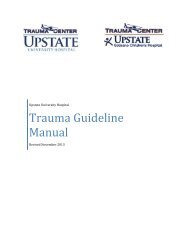Department of Pediatrics Biannual Report 2008-2009
Department of Pediatrics Biannual Report 2008-2009
Department of Pediatrics Biannual Report 2008-2009
Create successful ePaper yourself
Turn your PDF publications into a flip-book with our unique Google optimized e-Paper software.
Bi-Annual <strong>Report</strong> • 5<br />
EDUCATION PROGRAM IN GENERAL PEDIATRICS<br />
FACULTY<br />
Ann S. Botash, MD, Pr<strong>of</strong>essor <strong>of</strong> <strong>Pediatrics</strong>, Vice Chair for<br />
Educational Affairs<br />
Graduate Medical Education<br />
John Andrake, MD, Associate Pr<strong>of</strong>essor <strong>of</strong> <strong>Pediatrics</strong>,<br />
Director <strong>of</strong> Residency Program<br />
Bradley Olson, MD, Associate Pr<strong>of</strong>essor <strong>of</strong> <strong>Pediatrics</strong>,<br />
Associate Director <strong>of</strong> Residency<br />
Gloria Kennedy, MD, Assistant Pr<strong>of</strong>essor <strong>of</strong> <strong>Pediatrics</strong>,<br />
Associate Director <strong>of</strong> Residency<br />
Undergraduate Medical Education<br />
Charles Bergstrom, MD, Assistant Pr<strong>of</strong>essor <strong>of</strong> <strong>Pediatrics</strong>,<br />
Clerkship Director<br />
Robert Hingre, MD, Assistant Pr<strong>of</strong>essor <strong>of</strong> <strong>Pediatrics</strong>,<br />
Associate Clerkship Director<br />
Administrative<br />
James F. Peacock, MS, Education Program Administrator<br />
Patricia Mondore, MA, Residency Program Coordinator<br />
Carol Plumley, Clerkship Coordinator<br />
OVERVIEW<br />
For more than fifty years, the <strong>Department</strong> <strong>of</strong> <strong>Pediatrics</strong><br />
has maintained a residency training program in<br />
general pediatrics that provides residents with a<br />
strong foundation in primary care pediatrics, acute<br />
care medicine and all subspecialties. Our collegial<br />
environment allows a “hands on” approach with a low<br />
faculty to resident ratio. Due to the large catchment<br />
area served by the department, residents directly care<br />
for patients with a vast array <strong>of</strong> medical problems,<br />
from common primary care issues to the most unique<br />
subspecialty conditions. Residents are actively involved<br />
in varied learning experiences such as resident run journal<br />
clubs, research and pathophysiology conferences, casebased<br />
ambulatory care and subspecialty conferences,<br />
daily rounds with faculty, weekly grand rounds, and<br />
regular discourse with visiting pr<strong>of</strong>essors. Our allencompassing<br />
curriculum has successfully prepared<br />
residents for fellowship training in subspecialties and<br />
careers in primary care pediatrics across the country. In<br />
<strong>2008</strong>, the residency received a full five-year accreditation<br />
from the ACGME with no citations.<br />
Our 6-week clerkship provides pediatric education to<br />
about 120 students every year. The students are exposed<br />
to extensive in-patient (3 weeks) and out-patient (3 weeks)<br />
experiences. They attend thirty core lectures given by<br />
the faculty and are required to study CLIPP (Computer<br />
Learning in Pediatric Project; www.clippcases.org) cases.<br />
A teaching attending is assigned to the students during<br />
their in-patient rotation.<br />
RESIDENCY CURRICULUM<br />
The broad-based curriculum enables residents to<br />
become competent in all areas <strong>of</strong> general pediatrics.<br />
Some <strong>of</strong> the highlights <strong>of</strong> the curriculum include:<br />
• Seminars - In 2007, the core curriculum for the<br />
residents was updated with some innovative<br />
changes. The faculty have translated the core<br />
curriculum to an on-line environment that is<br />
available to the residents anytime and anywhere.<br />
The material is contained within Blackboard and<br />
resident participation in the online curriculum is<br />
actively monitored. The first year residents have<br />
a separate case based series <strong>of</strong> seminars and the<br />
senior residents attend a more in depth seminar on<br />
the same topics later in the day. These interactive<br />
seminars reinforce and complement the on-line<br />
lectures and <strong>of</strong>fer and interactive approach to<br />
learning through cases. Residents complete quiz<br />
materials online that can be used for preparation<br />
for the board examination.<br />
• Primary care – The training in primary care takes<br />
advantage <strong>of</strong> the well-developed division <strong>of</strong> general<br />
pediatrics and takes place at the University Pediatric<br />
and Adolescent Center (UPAC). The residents<br />
participate in a continuity clinic experience one<br />
half day per week. In addition, there are six<br />
separate month-long block rotations at UPAC.<br />
This combination <strong>of</strong> experience provides residents<br />
with a greater continuity for health maintenance,<br />
chronic diseases and acute illnesses. In the second<br />
year, residents combine their UPAC experience<br />
with longitudinal training in the outpatient clinics<br />
<strong>of</strong> various subspecialties. An additional rotation in<br />
Adolescent Medicine rounds out their education<br />
in general pediatrics. Community practices are<br />
also available as sites for resident education, and<br />
nicely complement their training in the inner city,<br />
hospital-based UPAC.<br />
• Critical Care – The Golisano Children’s Hospital<br />
PICU is the setting for the training in Pediatric<br />
Critical Care Medicine. Residents provide direct<br />
patient care for the sickest children in Central<br />
New York, with a wide-range <strong>of</strong> acute conditions.<br />
Residents also provide concurrent care for<br />
patients admitted primarily for surgical conditions.<br />
Residents have exposure to Neonatal Intensive Care<br />
through two distinct NICU experiences, first at St.<br />
Joseph’s Hospital Health Center and subsequently<br />
at the tertiary care NICU at Crouse Hospital.<br />
• Emergency Medicine – Residents are the front line<br />
for children up to 18 years <strong>of</strong> age who come with<br />
medical or surgical emergencies to the area’s only<br />
Pediatric Emergency <strong>Department</strong>. More than 20,000<br />
annual visits are seen, and supervised by board<br />
certified Pediatric Emergency Medicine faculty.

















